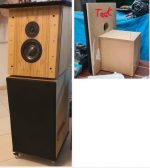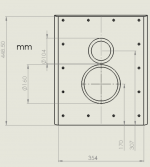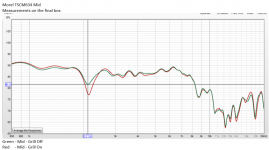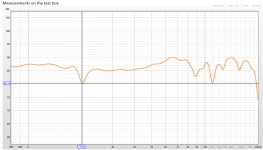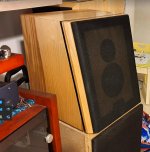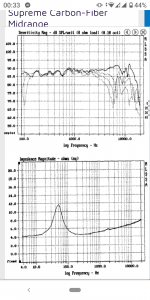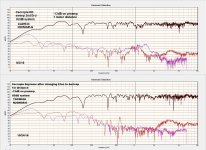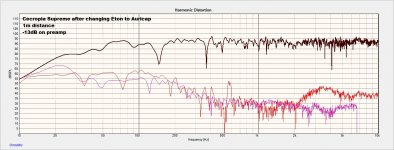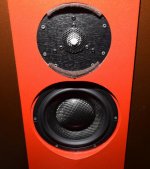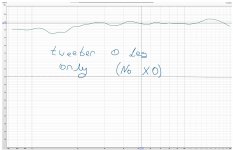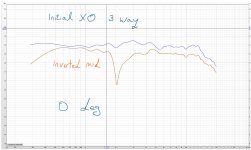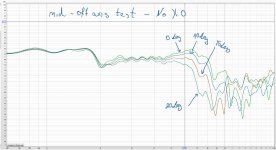Hi
I'm building a 3 way speaker using morel components:
Tweeter: TSCT1044
Mid:TSCM634
Woofer: TiCW1258Ft
The speaker is divided to two boxes. one for the mid and tweeter and one for the woofer.
I started by building test box and advanced from there.
I saw a problem with the test box of the mid but i thought it was in issue with the internal of the box. but it looks like I was wrong.
After building the final box i saw the same problem.
The problem is a notch in the midrange measurements. -5db @ 2.1khz.
Ok so then I was thinking it is something with the edges of the box.
0.5 of the baffle width wave length is very close the 2khz.
I tried some kind of improvisation to increase the baffle width but it did not have any effect on this dip.
I was able to fix it in the XO but it is a constrain that i wish to get rid of.
I wish to understand the problem and may be to avoid it in the next design.
See attached files.
Thanks
Ran
I'm building a 3 way speaker using morel components:
Tweeter: TSCT1044
Mid:TSCM634
Woofer: TiCW1258Ft
The speaker is divided to two boxes. one for the mid and tweeter and one for the woofer.
I started by building test box and advanced from there.
I saw a problem with the test box of the mid but i thought it was in issue with the internal of the box. but it looks like I was wrong.
After building the final box i saw the same problem.
The problem is a notch in the midrange measurements. -5db @ 2.1khz.
Ok so then I was thinking it is something with the edges of the box.
0.5 of the baffle width wave length is very close the 2khz.
I tried some kind of improvisation to increase the baffle width but it did not have any effect on this dip.
I was able to fix it in the XO but it is a constrain that i wish to get rid of.
I wish to understand the problem and may be to avoid it in the next design.
See attached files.
Thanks
Ran
Attachments
For a 6" driver a dip can't be caused by the baffle, so it should be caused by the driver itself. The SBA Satori has a similar dip, although lower in frequency. I wouldn't try to fix it in the crossover, what did you do?
Ralf
Ralf
Morel TSCM634 6"
Not from the factory. Maybe from the phase with the crossover or distance of measurement (to close)? Also visible (artifact) in inverter tweeters (Focal).
Not from the factory. Maybe from the phase with the crossover or distance of measurement (to close)? Also visible (artifact) in inverter tweeters (Focal).
Attachments
It is NOT caused by the driver itself. Measure the mid separately by disconnecting a wire from the tweeter. The dip will vanish. This is classic crossover frequency misalignment caused by improper acoustic summing of the drivers on axis due to non-coincident propagation planes (acoustic offset front-to-back. Tweeter is forward on a flat baffle). The central lobe will be steering either up or down rather than straight ahead. Repeat acoustic measurements with mic at various heights to see where the lobe is steering (a flat response across crossover). Something like a lattice phase equaliser added to the tweeter network will address it. Or a redesign of the crossover network in general.
Try switch polarity for say the tweeter and measure the response again, the interaction between the elements should come out different if the problem lies in the filter.
The OP didn't explain in details all things, but from what he wrote it should be pretty clear that the measure was related to the mid only. Maybe we need a clarification.
Ralf
The datasheet shows an impedance blip at roughly the same frequency of the FR dip, something to ponder on. I do concur that an improper measuring distance will lead to a false FR, considering the baffle width you need to measure at least 1m away.Not from the factory. Maybe from the phase with the crossover or distance of measurement (to close)?
Ralf
That impedance variation might go along with the changing breakup modes in that band. Agree there is little to go on.
Measure at 1 m on axis and say, 10/20/30 degrees off-axis.
See if the dip remains or it changes. This way you can conclude if it is baffle or driver related.
See if the dip remains or it changes. This way you can conclude if it is baffle or driver related.
And the baffle layout isn't perfect, I might add. Both the mid and the tweeter have equidistant positions to three of the four 'rather edgy' edges. On-axis measurements at 2m should show up diffraction dips and possibly peaks too. Since the grill-on measurement shows a little frequency shift upwards, I wouldn't count out diffraction.
I'd try measuring it at 2m (tho acquiring a time window big enough could be challenging) on- and off axis, make impedance plots and make CSD's (rather BD-plots) of the mid close range (1-2cm from the cone).
I'd try measuring it at 2m (tho acquiring a time window big enough could be challenging) on- and off axis, make impedance plots and make CSD's (rather BD-plots) of the mid close range (1-2cm from the cone).
Morel drivers usually have 0-1mm of AC offset with their tweeters and woofers. You made the sloped baffle, and that ruined the alignment that is inherent. Measure perpendicular to the tweeter mounting plane, and the dip might just disappear.
Later,
Wolf
Later,
Wolf
The dip appears also in the response of the mid alone, IIRC.Morel drivers usually have 0-1mm of AC offset with their tweeters and woofers.
Well I never knew that. Every day is a school day.
Jeff B found that out when he did the Solstice design. He did not have any offset he felt that needed to be accounted for.
Wolf
The dip appears also in the response of the mid alone, IIRC.
It did not on my TSCW636 woofers, and the cones are identical. The SCM/W and TSCM/W do not have the surround resonance dip that a lot of the other Morel woofers have. I had CAW634's before the upgrade to the TSCW636, and those had the surround dip. This was one of my major reasons for the upgrade.
Measurements attached show it does not exist on the newer driver.
What I'm seeing is maybe that the tweeter polarity might need reversed, or the xover is misaligned enough to cause the null in phase and a deeper null out of phase. These or the measurements were not taken at the correct axis, or it's a diffraction ripple induced blemish.
Later,
Wolf
Attachments
I meant the first measurement graph in the opening post. Of course my mind came across a phase invertion dip too, although this one would be unusually narrow. But the first graph rules that out.
Hi
Thank you all for the response!
I will upload more data do for off axis.
The measurement you see are the midrange drive only.
you don't see the dip when measuring the tweeter only.
The angle back of the baffle is 13 deg.
I found that at this angle the tweeter and mid are aligned from impulse response measurements.
Thank you all for the response!
I will upload more data do for off axis.
The measurement you see are the midrange drive only.
you don't see the dip when measuring the tweeter only.
The angle back of the baffle is 13 deg.
I found that at this angle the tweeter and mid are aligned from impulse response measurements.
I think the time window of your impulse measurement is too small. Did you do a close range measurement of the mid with time window >20ms?
"Mid off axis - straight connection (No xo)" Strange result if direct coupled. Same on both? Compair Distortion tabs between L & R, to see if one have had a coil melt.
- Home
- Loudspeakers
- Multi-Way
- Dip in the mid
